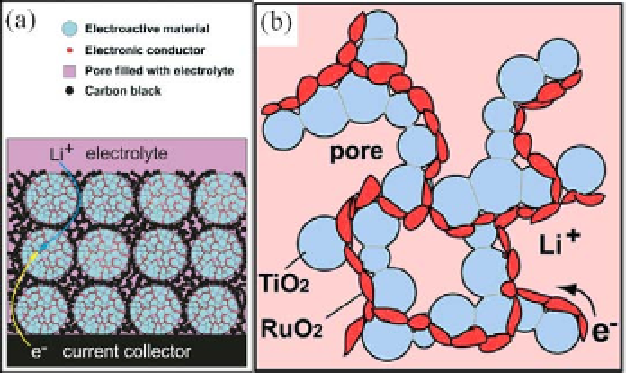Biomedical Engineering Reference
In-Depth Information
the prepared nanocomposite shows superior high rate capability
when used as anode material for lithium-ion batteries [34]. As can
be seen in Fig. 6.8, the nanoscopic network structure is composed
of a dense net of metalized mesopores that allow both Li
+
and
to migrate; thereby, the effective diffusion length is reduced.
Moreover, this network with mesh size of about 10 nm can be
overlapped by another net with similar structure on the micron-
scale formed by the composite of the mesoporous particles and
the conductive admixture. Besides, RuO
e
-
formed during
Li insertion also allows for quick Li permeation, and this can be
proved by the fact that at a very high charge/discharge rate of
30 C, the specific charge capacity of the composite is 91 mAh g
or Li
RuO
2
x
2
-
1
,
nine times larger than that of the original mesoporous TiO
spheres
2
(10 mAh g
-
1
).
nanocomposites. (b) Schematic
illustration of the self-wired path of deposited RuO
Figure 6.8.
(a) Sketch of TiO
:RuO
2
2
nanoparticles (all
reproduced with permission from [34], copyright 2007, Wiley-VCH Verlag
GmbH & Co. KGaA).
2
The concept of hierarchical 3D mixed conducting networks
has also been successfully used in constructing high rate cathode
materials such as LiFePO
. It has been found that benefiting from the
combining use of carbon and nanometer-sized RuO
4
as electronic
interconnects, the kinetics and rate capability of the composite of
C-LiFePO
4
2
-RuO
are significantly improved [67].
2









Search WWH ::

Custom Search